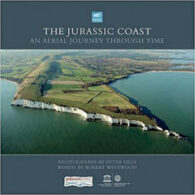By Robert Westwood

The Jurassic Coast Trust has produced a truly fascinating little picture book illustrating the geology of this World Heritage Site.
It has the shape, form and feel of a holiday souvenir book – the sort you buy in tourist information shops to commemorate your visit, with pictures of the sites you didn’t have time to see. And, there is plenty of information for the curious visitor wanting to learn more about the earth science of the area. However, that isn’t the reason why I find it really interesting.
The eponymous conceit of the guide is obviously to show the geology of this famous stretch of coast through aerial pictures. As someone who has done his fair share of tramping along beaches looking for fossils and trying to understand the geology, I have to admit I tend to see the cliffs, beaches and mudflats in two dimensions.
However, to do so is to forget the fact that the coast is a product of the three dimensions of geology of the neighbouring land and the photographs in this guide clearly show how the shape of the coast reflects the structure of its hinterland.
The best example is perhaps Lulworth Cove, with the aerial pictures unambiguously displaying the ridge of hard chalk, which slows the backwards erosion of the bay, extending parallel to the coast. The softer Wealden clays – in which the cove itself is shaped – appear flat and low in between the chalk and the hard limestones abutting the coast. In this way, the shape of the cover is entirely understandable in a way that walking around the beauty spot could never achieve.
Of course, the book more than adequately handles the fascinating geology of the area – from the red deserts of the Triassic, through the tropical seas of the Jurassic, the marshy braided rivers and dinosaurs of the Lower Cretaceous, to the algal blooms of the Upper Cretaceous chalk seas. And the diagrams – showing the positions of the continents through time and the relationships of the different sediments – explain the science more than adequately. However, it is the beautiful pictures that tell the story of why the coast looks as it does today and perhaps is the reason why you should buy it.
The Jurassic Coast: An Aerial Journey through Time, photographs by Peter Sills and words by Robert Westwood, Coastal Publishing, Wareham, Dorset (2011), 126 pages (hardback), ISBN: 978-19-07701-02-3


